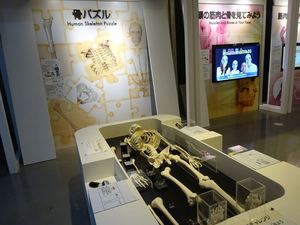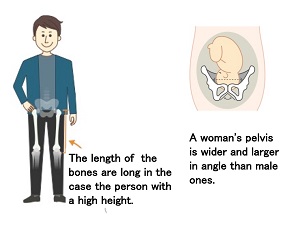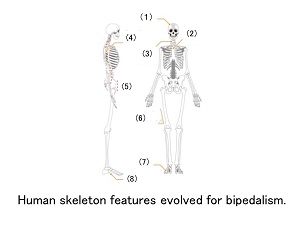Nagoya City Science Museum
TOP > Exhibition Guide > Floor Map> Human Skeleton Puzzle
Human Skeleton Puzzle



Purpose of Exhibition
This is a three-dimensional puzzle that enables users to disassemble some parts of a human skeleton model and assemble them again.
A total of six parts, which are all long bones, can be removed from the skeleton model: three bones in the right arm (humerus, ulna, and radius) and three bones in the right leg from the thigh to the ankle (femur, tibia, and fibula).
Try to build a skeleton model, referring to the left side of the body which is a complete model. Some marks on the table can be clues for assembly.
Once you finish assembling the skeleton, be sure to put the six bones back where they were.
You will notice three large bone and joint models displayed there, which were created in 1989 when the Life Science Building opened and remained on display until 2015.
Additional Knowledge
[Take a close look at bones!]
First, take a look at the shape of the six long bones presented as pieces for the skeleton puzzle. The ends of each bone are connected to other bones to form a joint. How do these joints work?
Try to put the six bones in the right positions, referring to the left side of the body which is a complete skeleton model. Why do you think bones located in similar positions are different in size and shape?
[Joints and their movements]
Three models displayed here represent three types of joints: a hinge joint (knee), saddle joint (base of the thumb), and ball-and-socket joint (shoulder). Touch and move these joint models, and you will find that each joint moves only in one direction, from front to back or from side to side, and on a large angular scale. Please compare these models with your body.
Two sets of facts are provided on the wall near the skeleton puzzle.
[What do the size and shape of bones tell us?]
A woman’s pelvis, or the lower part of the trunk, is wider in width and larger in angle than that of a man so that a baby can be raised within the uterus when giving birth. The length of the femur tells us about what type of frame the person has: a tall person usually has a long femur.
Frequently-used muscles develop well, which at the same time encourages the growth of relevant bone parts. That is why bones tell us, to some extent, what kind of life the person was living.
[What kind of bone shape is unique to humans?]
Humans walk upright, so their skeletons are adapted for regular walking on two legs.
The shape of bones in people’s lower body in particular (such as pelvis, femur, and leg bones) is extremely different from that of other animals.
Another unique aspect of the human skeleton is bones designed to protect and support a large skull and a heavy brain. The following are some examples. Please check them looking at the human skeleton model.
(1) A big head
(2) A wide chest and pelvis
(3) Neck bones right under the head
(4) An “S”-shaped backbone when viewed from the side
(5) Straight pelvis
(6) Tilted femur
(7) Five fingers that point in the same direction
(8) Arch of the foot
Article by Tomoko Horiuchi, curator
